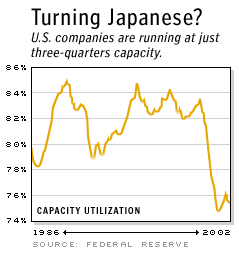NEW YORK (CNN/Money) - You wouldn't expect your plumber to be much help in setting a broken bone. You wouldn't think your dentist would be much help with your leaky roof.
Maybe it's time to stop thinking the Federal Reserve or the fiscal stimulus getting cooked up in Washington can do much to resurrect an economy that seems more Japanese by the minute.
No, that's not the majority view right now: Thanks to the beauty of easy money and a great big stimulus package, economists surveyed by the Philadelphia Fed think that by the end of the year the economy will be growing at a 4.2 percent annual rate, the unemployment rate will have fallen from the current 6 percent to 5.8 percent and U.S. corporate profits will be up by 10 percent.

But the experience so far casts some doubt on such a happy outcome. Consider how little has come of the Fed cutting the fed funds target rate to 1.25 percent from 6.5 percent just over two years ago, or the tax rebate that got doled out to U.S. households in 2001.
And yet the economy is barely inching along -- economists surveyed by Briefing.com think gross domestic product grew at a rate of only about 0.9 percent in the fourth quarter. Yes, some of that weakness is likely related to Iraq, and some is likely due to the scandals that wracked Corporate America last year. But again, the Fed's taken the funds rate down to its lowest level in 40 years. Shouldn't that count for something?
"When you think of all the fiscal and monetary stimulus we've had, we should have the economy growing at 5 or 6 percent," said David Rosenberg, chief North American economist for Merrill Lynch. "The fact that we're not is the story."
The wrong wrench
The problem, thinks Rosenberg, may be that the tools the Fed and the White House have at their disposal aren't appropriate for the job at hand.
Until now, every recession in the post-World War II era was tied to some sort of falloff in demand -- typically because the Fed had zigged, keeping rates too high, when it should have zagged. The solution to the problem of softening demand is to put money in buyers' hands. Lowering interest rates, and thus bringing borrowing costs down, is a great way to do that. So is putting $300 checks in people's mailboxes.
But the current downturn is unlike other downturns because its root was not a falloff in demand, but an investing bubble that led to more capacity (supply, if you think of it) than the economy could possibly sop up. Thanks to the readily available money pumping through the economy during the go-go '90s, Corporate America spent like crazy on new plants and equipment that it didn't really need. The hangover is that now companies are only operating at about three-quarters of capacity, according to the Federal Reserve.
"Basically we made a lot of ill-advised investments," said Northern Trust chief U.S. economist Paul Kasriel. "We need to readjust the economy, and cheap credit isn't necessarily going to be the way to do that."
In short, according to Napier Investment Advisors head Ron Napier -- Salomon Brothers' chief Asian economist in the 1980s -- the United States' problems continue to look very much like Japan's.
The seeds of Japan's economic downturn, too, was a busted bubble, a four-year frenzy of stock market and real estate speculation that ended in 1990. The Japanese response to that downturn was a series of economic stimulus packages and the Bank of Japan's eventual dropping of overnight rates to the zero bound. The first of the big stimulus packages, Napier points out, came a decade ago, in 1993, and as with all the packages that followed, the economy's response was underwhelming.
"The reaction to their stimulus efforts have always been less than policy makers expected," said Napier. "In normal times those things are supposed to work, but the aftermath of a bubble is not normal."
Japan's problems continue largely because of the government's unwillingness to deal with chronic overcapacity. There are still too many "zombie" companies -- department stores, construction firms, and the like -- being kept alive because of the unwillingness of Japan's banks and the government to see them fail. This has in turn led to problems at the banks (which themselves are struggling with overcapacity). And, inevitably, demand, too, has been hit, as a weakening job climate curtailed consumers' willingness to spend.
Obviously the Fed hopes it won't come to that, but it's unclear what the Fed can do besides keep rates low and keep printing money in the hope that the United States' overcapacity issues resolve themselves more quickly than Japan's.
"It's really just a waiting game," said Arnhold & S. Bleichroeder economist James Padinha. "You can't expect excesses to be done correcting just because you want them to be done correcting."

|

